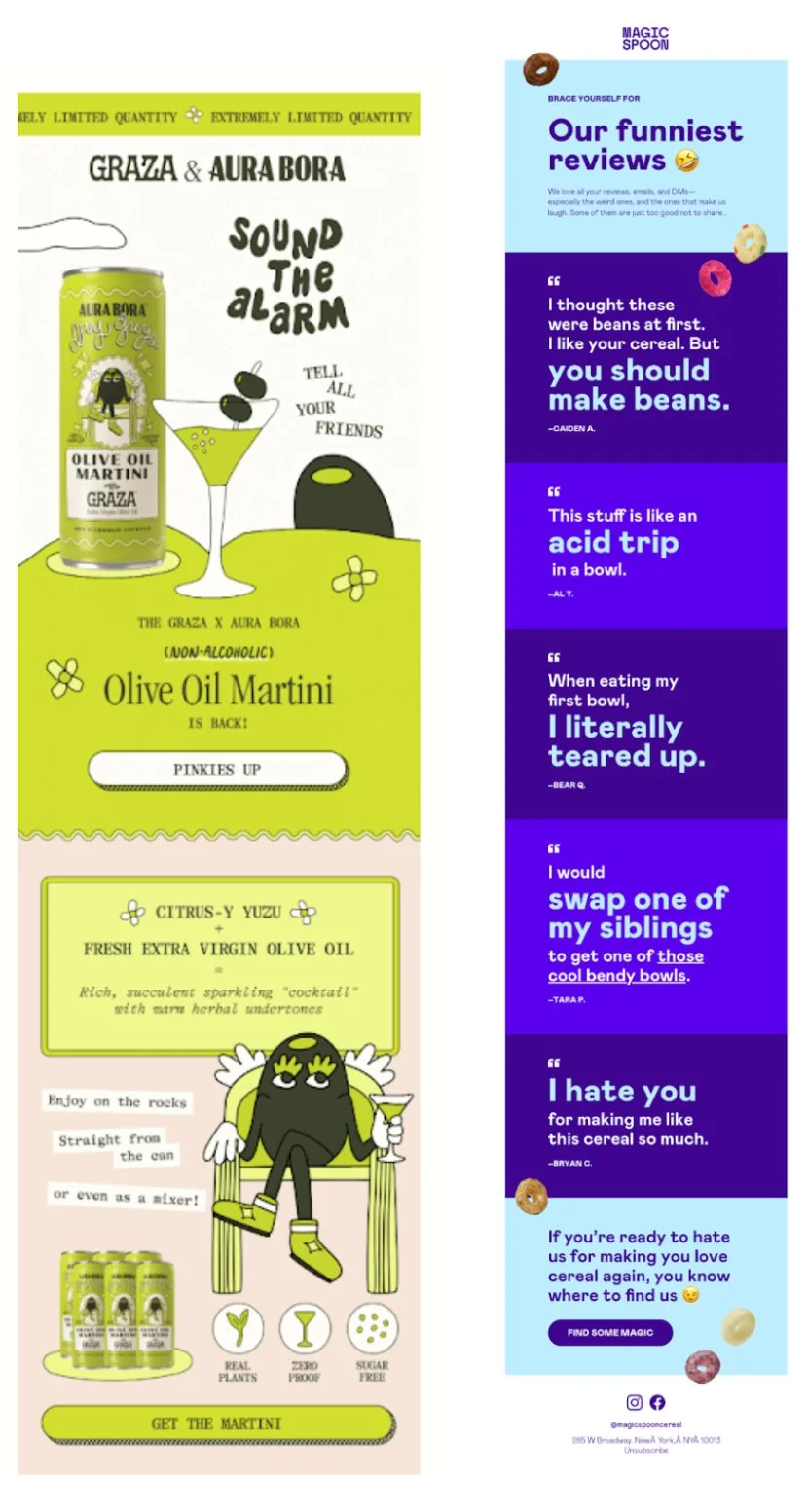Email Marketing: 2024 Highlights and 2025 Predictions
Discover the biggest email marketing changes of 2024 and our team's predictions for 2025, from AI and gamification to smarter inboxes and dynamic content.
2024 brought significant changes to email marketing—AI integration, gamification, and rising deliverability challenges reshaped how brands connect with audiences. Our team took a moment to reflect on these shifts and share insights into the biggest changes we’ve seen, while making bold predictions for what’s in store for 2025.
From dynamic content to smarter inboxes and deeper customer insights, we explore the trends shaping the future of email marketing.
MKTG Rhythm Team
Major changes in 2024
Predictions for 2025
Major changes in 2024
Predictions for 2025
Major changes in 2024
Predictions for 2025
Major changes in 2024
Predictions for 20205
Major changes in 2024
Predictions for 2025
Major changes in 2024
Predictions for 2025
Robbie Fitzwater
Major changes in 2024
Lots of headwinds in terms of measurement and deliverability
As a whole, most of the things that changed were relatively similar but I feel like email is following the path of organic search in the way that it is getting more and more technical and specific as time goes on. Also, with so many different compliance changes happening, the need to stay ahead and keep evolving has never been more important.
Bot clicks overinflating performance
“Unsubscribing” from emails has never been easier
There were more emails sent during critical selling windows than before
SMS is continuing to deepen its relationship with email
2024 saw a lot more attention going to email as a channel for retaining existing customers, or marketing expectations for email increased.
Predictions for 2025
Email will become a more critical listening post for customer insights. We will see more groups use email as a way to gather strategic insights from their customers that can inform areas across their business:
Understanding how to improve product experience
Understanding how customers make decisions around specific products
Capturing the voice of the customer research to understand how to speak about products and services
Understanding issues preventing someone from purchasing
The list of use cases can go on forever, but as a whole, this opens up a whole new set of opportunities for businesses.
Then taking these insights and applying them across the business in addition to applying them in email. Gaining specific insights around specific segments helps everyone because that insight can illustrate nuance across the organization.
2. Gmail and other platforms will move closer to “contextual” inbox: This has been on the radar for a while now but thinking we will see more contextual timing for inboxing moving forward. Basically, Gmail decides when you are most likely to find that content valuable.
They are not completely filtering your inbox, but they are planning to curate what reaches your inbox at what time rather than when marketers hit “send”. Apple has announced a good amount around this also, so understanding how the systems work and how to reach the inbox when you need to will be super important!
This will be framed as a positive for consumers but will end up giving email clients quite a bit more power to edit and filter inboxes. Like social algorithms, they want more control over the process.
Jesse Godfrey
Major changes in 2024
AI-Frenzy
Through much of 2023 and all of this past year, brands and marketers have scurried to find how generative AI fits into their processes and tools.
The arrival of mainstream AI has felt stress-inducing, with what seems like a new tool arriving on the scene every few weeks. Marketers have left no stone unturned looking for ways to integrate the technology, but are only finding a few lanes where it is proving fruitful for creating and editing content.
Still, with much of the email marketing space relying on Email Service Providers (ESPs) technology to distribute, I believe we’ve yet to see the full evolution of AI-powered email marketing. It’s likely the biggest and most transformational advancements in email marketing lay with the ESPs and how they will continue to develop products that leverage the technology to streamline automation and analytics.
Predictions for 2025
Surge of third-party ESP integrations
With tools like getrepeat.io and wonderment.com have already established a place in the e-comm space, I think we’ve only scratched the surface of the symbiotic relationship between smaller niche tech solutions and the major EPSs.
As long as the “play-nice” mentality continues with the ESPs, unique and game-changing tech solutions will continue to emerge, making it easier to leverage data to create hyper-personalized, engaging email operations.
Edvina Nesukaityte
Major changes in 2024
Adding gaming experience to emails
Just like social media marketers, email marketers must continually learn new skills and expand their toolkits. Each year, email marketing pushes the boundaries of what’s possible, breaking through limitations and unlocking new capabilities. This year, we’ve seen emails become more interactive and engaging, featuring elements like quizzes, progress bars, and scratch cards. Gamification has emerged as a powerful way to capture attention, boost engagement, and drive conversions. It also adds a modern, dynamic touch to emails, making them especially effective for connecting with younger audiences like Gen Z.
Predictions for 2025
As CRM software continues to evolve with advanced AI-driven personalization and analytics tools, we can anticipate a surge in the use of dynamic content in email marketing. AI will enable real-time customization of email content based on individual preferences, past behavior, and live data, enhancing the customer experience and equipping email marketers to better meet audience needs.
Segmentation has long been a cornerstone of successful email marketing strategies, and AI is set to take it to the next level. The good news is that AI will refine customer segmentation by identifying subtle customer segments and micro-segments, enabling marketers to create more targeted and impactful campaigns. Additionally, AI’s predictive capabilities will allow marketers to anticipate future customer behavior, proactively segment their audiences, and deliver tailored messages that truly resonate.
Bailey Hack
Major changes in 2024
Storytelling
Email marketers quickly realized that capturing a user’s attention required more than just creativity—we had to tell a story. The white noise of standard email templates no longer resonated with savvy, digital-native shoppers. Click rates were at an all-time low, and quippy subject lines alone couldn’t cut through the era of distraction. Gaining and keeping a user’s attention required more than ever before.
A new standard emerged. The old formula—”generic email copy + casually-selected static images = success”—was outdated. Instead, strategy and imagery needed to fuse into a cohesive, story-driven unit, breaking through the status quo of email communication. To truly engage users, brands had to create anticipation—emails so compelling that recipients eagerly awaited the next installment, curious to see what the brand would come up with next.
In 2024, “cheeky” became the defining trend in email marketing. The challenge for brands was clear: how do you pair immersive content with a touch of wit, earning a chuckle from users who think, “Well, wasn’t that clever?”
Predictions for 2025
I’m not usually one to make bold predictions, but here we go: I think something significant is going to change with email inboxes. Users are subscribed to far too many brands, and I foresee a shift where email providers will offer users the option to “start from scratch.” Only the top 1% of brands—the ones that truly provide value—will remain.
Not to spark mass hysteria, but I think this could actually be a positive change. It would push brands to either heavily invest in their email strategies or bow out of the arena altogether. This reset might also lead to a fresh approach in how users experience their inbox. Imagine if, instead of the standard list view, users saw email content first, compelling them to click for more, similar to how social media stands today. Subject lines alone wouldn’t be the deciding factor anymore—it would be about storytelling and real value.
I believe this shift could foster stronger brand loyalty and reduce the reliance on over-promotion. Maybe this means brand value and storytelling are in, while the traditional Black Friday frenzy and begging for opens is on its way out.
Again, why bother making a prediction if it’s not bold?
Carese Brown
Major changes in 2024
Increase in video elements
This year may have been the most I’ve seen brands implement video elements in their emails. The increase in embedded videos or videos as GIFs has been fun to see. From food and beverage companies to toy companies, they have adopted the concept and added some type of movement to their emails.
Instead of having them link to external sources, they can link directly to a page on their site to drive traffic and create a seamless user experience. A video element can help brands connect emotionally with their audience, increasing retention and loyalty. Also, this has helped clear up any confusion about certain products by conveying information in a digestible way.
One of my favorite brands to receive emails from is Bachan’s. Here are two examples of video elements they’ve implemented in their campaigns.
Predictions for 2025
Sustainable email marketing
You may ask, How is email marketing already not sustainable with it being paperless? Just because it’s paperless doesn’t mean it can’t use energy. The data has to be stored somewhere. My guess is that there are about a billion emails sent daily, and that number has drastically increased during the political years. According to Mike Berners-Lee’s 2010 book, “How Bad Are Bananas,” BBC reported that a single email can exert 4g of CO2 while one with a heavy attachment has 50g of CO2. Still, those may have increased due to the increase in tech, according to Charlotte Freitag, a carbon footprint expert.
This is where updating and cleaning your email lists comes into play. You should already prioritize your most engaged audience, but personalized, meaningful content emails are also essential to lower the number of ignored emails, which can increase user engagement.
Ben Dority
Major changes in 2024
Building relationships and fostering connections remain key goals for marketers. Email offers value beyond transactions, and I’ve noticed more brands using it to deepen their connection with customers.
One brand that consistently stood out in my inbox was Poppi, the delicious prebiotic soda. They caught my attention with something so simple: their deliberate lack of capitalization in everything—sender name, subject line, and preview text.
In a world of email marketing dominated by “Camel Case” or attention-grabbing “ALL CAPS” styles, I believe poppi has carved out a unique differentiation tactic that helps them stand out and drive opens in the inbox.
Predictions for 2025
Segmentation is already foundational to a successful marketing strategy. As it relates to email, segmentation by previous purchase behavior or type of customer have already both proven themselves as winners.
In 2025, it is my belief that brands will begin to use email to segment and ultimately communicate differently with different age groups – similar to the way Instagram and other social media sites already use age as a primary factor in ad targeting. As Gen-Z continues to grow its population in the workforce and earn more disposable income, the best email efforts will segment campaigns and automations to communicate with the generation in a manner that is both concise and genuine.










